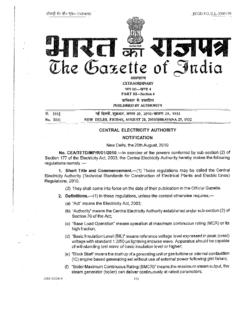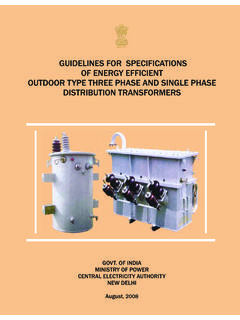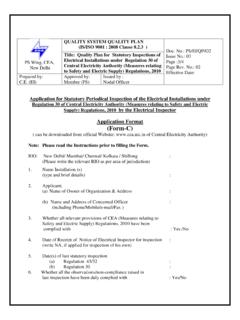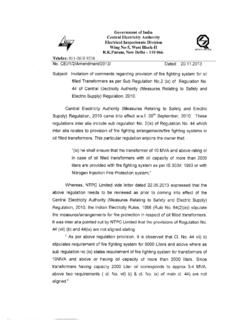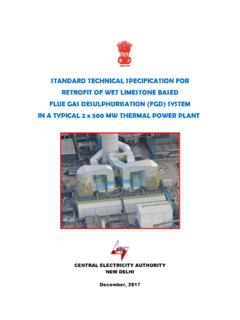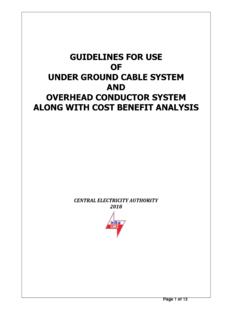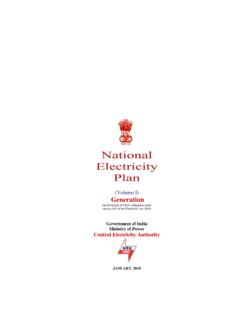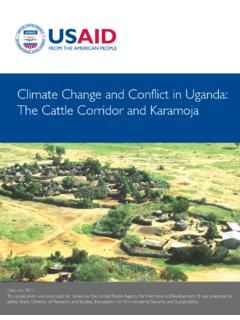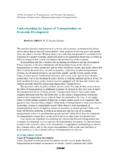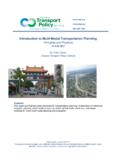Transcription of CENTRAL ELECTRICITY AUTHORITY NEW DELHI JANUARY …
1 MANUAL. ON. TRANSMISSION PLANNING. CRITERIA. CENTRAL ELECTRICITY AUTHORITY . NEW DELHI . JANUARY 2013. Manual on Transmission Planning Criteria MANUAL. ON. TRANSMISSION PLANNING. CRITERIA. CENTRAL ELECTRICITY AUTHORITY . NEW DELHI . JANUARY 2013. CENTRAL ELECTRICITY AUTHORITY -1- Manual on Transmission Planning Criteria MANUAL ON TRANSMISSION PLANNING CRITERIA. CONTENTS. Preamble 4. Scope and planning philosophy 1. Scope 5. 2. Applicability 5. 3. Planning philosophy and general guidelines 6. Criteria for steady-state and transient-state behavior 4. General principles 8. 5. Permissible normal and emergency limits 9. 6. Reliability criteria 11. Criteria for simulation and studies 7. System studies for transmission planning 14. 8. Power system model for simulation studies 14. 9. Load - generation scenarios 15. 10. Load demands 15. 11. Generation dispatches and modeling 17. 12. Short circuit studies 18. 13. Planning margins 19. Additional planning criteria and guidelines 14.
2 Reactive power compensation 20. 15. Sub-station planning criteria 22. 16. Additional criteria for wind and solar projects 23. 17. Additional criteria for nuclear power stations 24. 18. Guidelines for planning HVDC transmission system 24. CENTRAL ELECTRICITY AUTHORITY -2- Manual on Transmission Planning Criteria 19. Guidelines for voltage stability 25. 20. Guidelines for consideration of zone-3 settings 25. Annexure-I : Definitions 26. Annexure-II : Abbreviations 27. Annexure-III : Generation and load factors 29. Annexure-IV : Load data from STUs 31. Annexure-V : Data for transmission planning studies 32. References 44. Drafting Committee 45. Acknowledgement 45. Explanatory Notes 46. CENTRAL ELECTRICITY AUTHORITY -3- Manual on Transmission Planning Criteria PREAMBLE. Manual on transmission planning criteria was first brought out by CEA in 1985. setting the planning philosophy of regional self sufficiency. The manual was revised in 1994 taking into account the experience gained on EHV systems.
3 Technological advancements and institutional changes during last ten years have necessitated review of Transmission Planning Criteria. The regional electrical grids of Northern, Western, Eastern and North-Eastern regions have been synchronously interconnected to form one of the largest electrical grids in the world. The country has moved from the concept of regional self-sufficiency to bulk inter-regional transfer of power through high capacity AC and HVDC corridors forming an all-India National Grid. The ELECTRICITY Act, 2003 has brought profound changes in ELECTRICITY supply industry of India leading to unbundling of vertically integrated State ELECTRICITY Boards, implementation of Open Access in power transmission and liberalisation of generation sector. The phenomenal growth of private sector generation and the creation of open market for ELECTRICITY have brought its own uncertainties. Large numbers of generation projects are coming up with no knowledge of firm beneficiaries.
4 The situation is compounded by uncertainty in generation capacity addition, commissioning schedules and fuel availability. All these factors have made transmission planning a challenging task. Adequate flexibility may be built in the transmission system plan to cater to such uncertainties, to the extent possible. However, given the uncertainties, the possibility of stranded assets or congestion cannot be entirely ruled out. In the creation of very large interconnected grid, there can be unpredictable power flows leading to overloading of transmission lines due to imbalance in load- generation balance in different pockets of the grid in real time operation. Reliable transmission planning is basically a trade-off between the cost and the risk involved. There are no widely adopted uniform guidelines which determine the criteria for transmission planning vis- -vis acceptable degree of adequacy and security. Practices in this regard vary from country to country.
5 The common theme in the various approaches is "acceptable system performance". However, recent grid incidents of July 2012 have underlined the importance of grid security. As the grid grows in size and complexity, grid security has to be enhanced because the consequences of failure of a large grid are severe. The transmission planning criteria has been reviewed accordingly. The transmission planning criteria has also considered large scale integration of renewable energy sources. CENTRAL ELECTRICITY AUTHORITY -4- Manual on Transmission Planning Criteria MANUAL ON TRANSMISSION PLANNING CRITERIA. Scope and planning philosophy (Paragraph 1 to 3). 1. Scope The CENTRAL ELECTRICITY AUTHORITY is responsible for preparation of perspective generation and transmission plans and for coordinating the activities of planning agencies as provided under Section 73(a) of the ELECTRICITY Act 2003. The CENTRAL Transmission Utility (CTU) is responsible for development of an efficient and coordinated inter-state transmission system (ISTS).
6 Similarly, the State Transmission Utility (STU) is responsible for development of an efficient and coordinated intra-state transmission system (Intra-STS). The ISTS and Intra-STS are interconnected and together constitute the ELECTRICITY grid. It is therefore imperative that there should be a uniform approach to transmission planning for developing a reliable transmission system. The planning criteria detailed herein are primarily meant for planning of Inter-State Transmission System (ISTS) down to 132kV level and Intra-State Transmission System (Intra-STS) down to 66kV level, including the dedicated transmission lines. The manual covers the planning philosophy, the information required from various entities, permissible limits, reliability criteria, broad scope of system studies, modeling and analysis, and gives guidelines for transmission planning. 2. Applicability These planning criteria shall be applicable from the date it is issued by CENTRAL ELECTRICITY AUTHORITY 1st February 2013.
7 These criteria shall be used for all new transmission systems planned after the above date. The existing and already planned transmission systems may be reviewed with respect to the provisions of these planning criteria. Wherever required and possible, additional system may be planned to strengthen the system. CENTRAL ELECTRICITY AUTHORITY -5- Manual on Transmission Planning Criteria Till implementation of the additional system, suitable defense mechanisms may have to be put into place. 3. Planning philosophy and general guidelines The transmission system forms a vital link in the ELECTRICITY supply chain. Transmission system provides service' of inter-connection between the source (generator) and consumption (load centers) of ELECTRICITY . In the Indian context, the transmission system has been broadly categorised as Inter-State Transmission System(ISTS) and Intra-State Transmission system(Intra-STS). The ISTS is the top layer of national grid below which lies the Intra-STS.
8 The smooth operation of power system gets adversely affected on account of any of these systems. Therefore, the criteria prescribed here are intended to be followed for planning of both ISTS and Intra-STS. The transmission system is generally augmented to cater to the long term requirements posed by eligible entities, for example, for increase in power demand, generation capacity addition etc. Further, system may also be augmented considering the feedback regarding operational constraints and feedback from drawing entities. The long term applicants seeking transmission service are expected to pose their end-to-end requirements well in advance to the CTU/STUs so as to make-available the requisite transmission capacity, and minimise situations of congestion and stranded assets. The transmission customers as well as utilities shall give their transmission requirement well in advance considering time required for implementation of the transmission assets.
9 The transmission customers are also required to provide a reasonable basis for their transmission requirement such as - size and completion schedule of their generation facility, demand based on EPS. and their commitment to bear transmission service charges. Planning of transmission system for evacuation of power from hydro projects shall be done river basin wise considering the identified generation projects and their power potential. In case of highly constrained areas like congested urban / semi-urban area, very difficult terrain etc., the transmission corridor may be planned by taking long term perspective of optimizing the right-of-way and cost. This may be done by adopting higher voltage levels for final system and operating one CENTRAL ELECTRICITY AUTHORITY -6- Manual on Transmission Planning Criteria level below in the initial stage, or by using multi-circuit towers for stringing circuits in the future, or using new technology such as HVDC, GIS etc.
10 In line with Section 39 of the ELECTRICITY Act, the STU shall act as the nodal agency for Intra-STS planning in coordination with distribution licensees and intra-state generators connected/to be connected in the STU grid. The STU. shall be the single point contact for the purpose of ISTS planning and shall be responsible on behalf of all the intra-State entities, for evacuation of power from their State's generating stations, meeting requirements of DISCOMS and drawing power from ISTS commensurate with the ISTS plan. Normally, the various intra-State entities shall be supplied power through the intra-state network. Only under exceptional circumstances, the load serving intra-State entity may be allowed direct inter-connection with ISTS on recommendation of STU provided that such an entity would continue as intra-State entity for the purpose of all jurisdictional matters including energy accounting. Under such situation, this direct interconnection may also be used by other intra-State entity(s).
